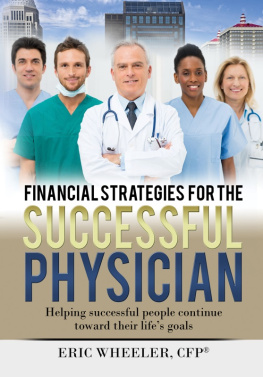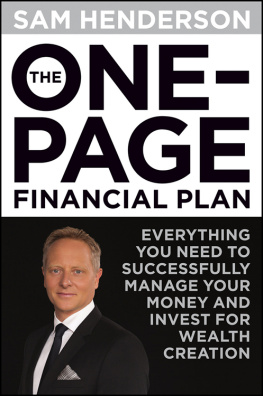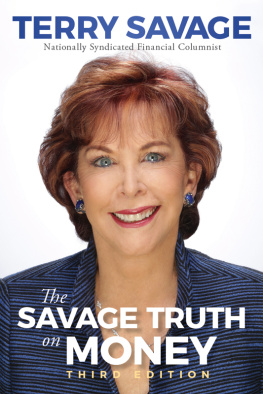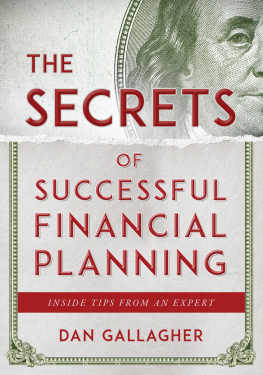Table of Contents
Introduction
When I was twenty-five years old, more than a few years ago, my grandfather passed away. He was an awesome man, the patriarch of our family. Hed been a successful entrepreneur, like his son, my father. The funeral home was packed with people, because Bill Wheeler had many friendspeople he had helped over the years and ones with whom he had been in business.
As I think about it today, I recall stories that many of those folks still tell about how he helped others with sound advice or financial gifts when they needed it the most. My grandfather gave money and assistance to charities and directly to people who were both successful or down on their luck. To others still, he loaned the money to start a business or to buy a home when nobody else would.
Because Bill Wheeler made smart decisions with his money, he was in a position to give generously of his time, talent and treasure. Make no mistake, he had a kind heart and would have done his best to help others, but he had an even bigger impact because of the confidence he had that his family would be financially secure.
My grandfather passed these qualities to my father as well. I watched Dad do the same thing over the years, helping folks in time of need with sound financial advice and supporting worthy causes and people. My father is a successful entrepreneur, who has managed several businesses, utilizing some of the very strategies in this book. He, too, has been able to help many others through his generosity and keen sense of money matters. Dad has made smart decisions with his money, and that made him comfortable in giving.
This desire to help others is in my DNA. I see a great opportunity to help people through advice and generosity the same way my father does today and the way his father did before him. Moreover, I see the tremendous benefit that I can make not only in my clients lives, by helping them make smart decisions, but also by helping them achieve the success and confidence with their wealth to spread their generosity beyond their families. My hope is to have an even larger impact on the world through my clients, helping them make smart decisions with their money so they can touch the lives of countless others in the same way my grandfather did.
Many physicians and dental professionals are not confident that they are on track for achieving success with their wealth for the many reasons that Ill share in this book. According to my research and that of CEG Worldwide, physicians and dental professionals tend to be concerned with five major areas:
1. They dont have the time, or are not taking the time to make smart decisions with their money.
2. Most are looking for strategies to relieve their tax burden so they dont have to pay any more than their fair share.
3. They dont have a well-defined plan for how theyll take care of their heirs.
4. They are concerned about protecting their assets from being unjustly taken.
5. Many of my clients give to charities that theyre passionate about. But they havent really figured out the most effective strategy to ensure their gifts have the maximum impact both for the charities and their personal finances.
Challenges Facing the Successful Physician
Over the past few months, I interviewed several successful physicians in OBGYN, Oncology, Radiology, Anesthesiology, Gastroenterology, Acute Care, General Surgery, Cardiology, Dentists, and Orthodontists, as well as individuals supporting the industry such as CPAs, attorneys, medical malpractice insurance specialists and IT professionals. The purpose of these interviews was to find out the most pressing financial issues facing physicians today and how the financial services industry might be able to help solve these problems.
Historically, doctors in these fields have been very successful in generating income and accumulating assets. However, as a group, many are unhappy, feel trapped working more hours than ever before and are stressed about the future. Add to that, declining reimbursement rates for many procedures are compounding the issue, as income compression now has many physicians even more concerned about their financial future. While many doctors and dentists are recognizing they may want to work into their late 60s or early 70s, having the financial independence to make work optional seems more elusive.
Indeed, the economy is getting better, which has in turn lifted many retirement plan balances and other assets from the abysmal levels we saw in the Great Recession of 20072009. However, many have been reluctant to recommit dollars back into the markets. While this period has caused many physicians to shy away from the stock and bond markets, their attitude toward investing must change. Otherwise, having the financial independence they desire is unlikely. Sending children and grandchildren to the college of their choice will be a financial strain, and tackling other family-related issues could take on a far different weight to the patriarch or matriarch than intended. So how did we get here?
Limited Time
While professionals in the dental field (e.g. dentists, orthodontists, and oral surgeons) are yet to see some of the effects from the Affordable Care Act (ACA, or Obamacare), other specialists are subject to more scrutiny on quality of care from Medicare and the tenets of the ACA. Despite the fact that patients and doctors both want the highest quality of care, the oversight in these areas puts additional strain on physicians to justify and document everything they do.
Of the physicians I interviewed in my research, maintaining Electronic Health Records is the number one challenge to their time management. Whether completing these records during the patient interaction, immediately following it, or at the end of the day, documenting the specifics of the patients visits has added hours to the day for both the physician in private practice and those employed through hospitals.
A close second in the time-robbing department, the RVU (Relative Value Unit) requirements being placed upon hospital employees further diminishes the time available to doctors for personal matters such as their family and planning for their financial future. According to Medical Economics, relative value units are calculated by dividing the physicians work into four subcomponents: the time it takes to perform the service, the technical skill and/or physical effort required to perform the service, the amount of mental effort and judgment required, and the stress arising from any potential risk to the patient from performing the service.
Each of these three components is assigned an RVU. Then, to account for variations in living and business costs across the country, each of the three components is multiplied by a factor known as the Geographic Practice Cost Index, or GPCI. The three components are added together, and the resulting sum is multiplied by a dollar amount known as the conversion factor to arrive at the reimbursement dollar figure.
Many doctors are working longer hours to see more patients in order to stay on track for bonuses tied to these RVUs. In many cases, future employment is dependent upon producing, or maintaining, the minimum RVUs. This can be difficult to attain in some areas, such as rural markets. In order to earn the same income as last year, successful doctors are striving for bonuses tied to additional RVUs, while others have given more time to their family and accepted the fact that their income may level out or decline somewhat.
Chasing dollars has put many on a hamster wheel thats difficult to exit, but what is the cost? Family life is certainly high on the list of things which can get squeezed out by the long hours. In addition, there is little time to manage personal affairs. The effort spent during high-earnings years to manage personal financial affairs is critical, since time in the market is essential for compounding returns. It is practically impossible to save enough money for retirement, especially in todays low interest rate environment, but allowing those dollars to compound at a rate higher than inflation and taxes can improve the likelihood of achieving your goal. The important thing is to invest early and often and to monitor your investment along the way.










